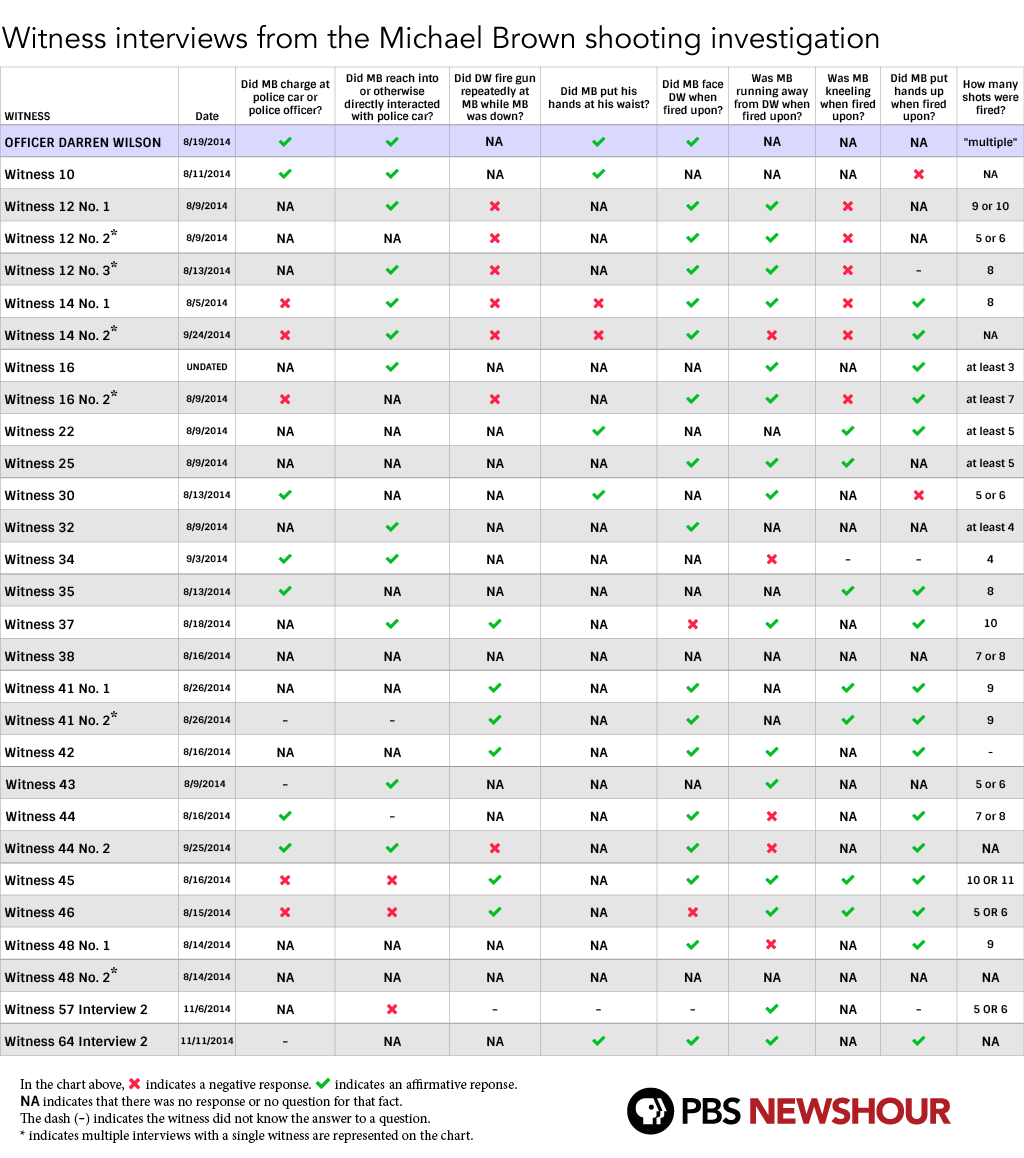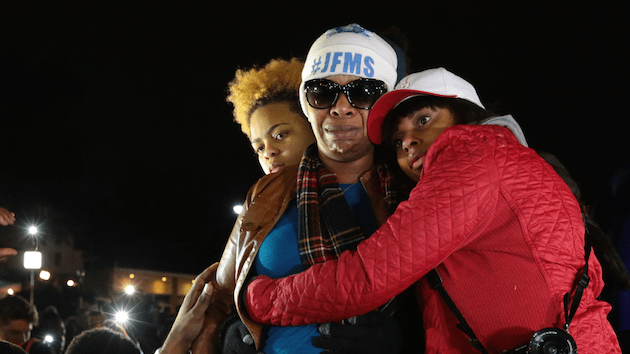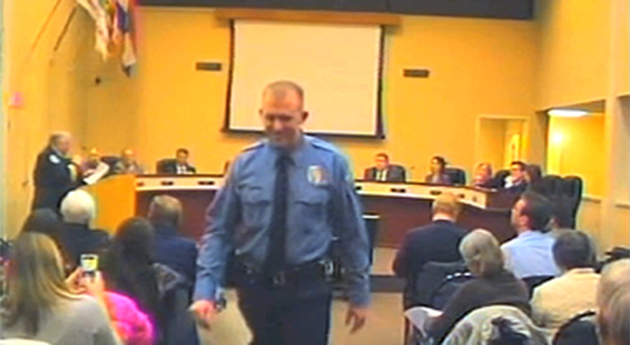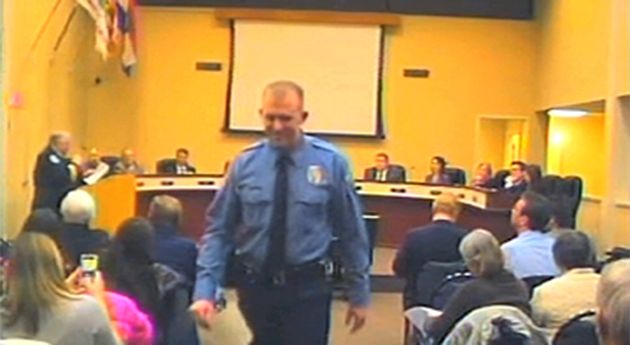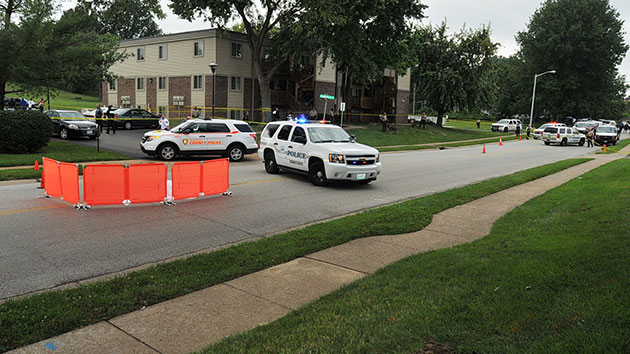
St. Louis County Prosecuting Attorney's Office
Since the St. Louis County prosecutor’s office released a trove of documents and evidence reviewed by the grand jury that decided to not indict Ferguson police officer Darren Wilson, there have been numerous reports pointing out the discrepancies between Wilson’s and various witness accounts of what happened on the day that Wilson shot and killed 18-year-old Michael Brown. While the grand jury has put an end to the state’s case against Wilson, questions about witness accounts could still sway the outcome of the Justice Department’s ongoing investigation. The Washington Post, Vox, St. Louis Post-Dispatch, PBS, and the Wall Street Journal have reported on these different accounts in further detail, especially the differences between the testimonies of Wilson and Dorian Johnson, a friend who was with Brown when Wilson approached them. We matched those accounts up with McCulloch’s statement during his announcement of the grand jury decision. Here are five key discrepancies:
1. What happened during Wilson’s initial encounter with Brown and Dorian Johnson?
Prosecutor Robert McCulloch: Wilson saw Brown and Johnson in the street, slowed down and told them to get on the sidewalk, and words were exchanged.
Darren Wilson: Wilson saw Brown and Dorian Johnson walking in the middle of the road. He told Johnson and Brown to get on the sidewalk. He noticed Brown was holding Cigarillos and remembered the report about the theft.
Dorian Johnson: Brown stole the Cigarillos from the Ferguson Market and then the two of them were walking toward their apartments as Wilson passed. Wilson told them to “Get the fuck on the sidewalk.”
2. How did the situation escalate?
McCulloch: Wilson reverses his car at an angle, blocking traffic and Brown and Johnson’s path. Wilson and Brown get into an altercation, with Wilson still in the car and Brown standing at the driver’s window.
Wilson: After Wilson told Brown and Johnson to get on the sidewalk, he says he heard Brown respond “fuck what you have to say.” He backed the car up to contain them, and asks Brown to come over to the car. He starts to get out of the car and Brown slams the door shut and says “what the fuck are you going to do about it.”
Johnson: Johnson says neither he nor Brown said a word and Wilson reversed his car unexpectedly, then opened his door and hit both him and Brown, and the door bounced back closed. Wilson then grabbed Brown by the shirt around his neck.
3. What exactly happened during Wilson and Brown’s “tussle”?
McCulloch: McCulloch says witness statements were inconsistent, with some saying Brown was never in the car at all, and others saying Brown was punching Wilson, some saying they were wrestling, and another saying that it was a tug-of-war. Two shots are fired during the altercation.
Wilson: After getting the door slammed on him, Wilson told Brown to “get the fuck back,” and tried to use the door to push him. Brown shut it again, and Brown then came “in my vehicle.” Brown punched Wilson. Wilson had one hand on his gun and tried to fire twice. Brown reached for Wilson’s gun. The gun goes off twice, and one bullet hits the door.
Johnson: Johnson says that Wilson reached his hand out of his car window and grabbed Brown’s shirt by his neck. A “tug of war” ensued with Brown trying to escape Wilson’s grip, but Brown’s hands never entered the car. After hearing the first gun shot, Johnson noticed blood on Brown, then turned and ran away. Brown followed behind him.
4. Did Wilson shoot at Brown and Johnson as they ran away?
McCulloch: McCulloch again says witness statements were inconsistent, with claims ranging from Wilson firing from the car, firing at Brown’s back as he was running, and others saying Wilson didn’t fire until Brown turned around and came back toward Wilson.
Wilson: Brown begins to run from Wilson after two shots were fired from the car. Brown runs but then turns around, and won’t comply with demands to get on the ground. Wilson says he didn’t open fire while Brown and Johnson ran away.
Johnson: Johnson hid behind a car, and watched as Brown ran past him and Wilson followed. Wilson opens fire while Brown is still running, at which point Brown stops and turns around. (Witness Piaget Crenshaw has told CNN Wilson shot as Brown ran away, adding that one bullet struck the building she was standing in. Another witness told investigators Wilson shot at Brown as he ran away.)
5. What was Brown doing when Wilson shot him?
McCulloch: McCulloch says witness accounts differ on whether Brown’s hands were up when he was facing Brown after turning around. Some say Brown didn’t move at all before Wilson shot him, others say he was in “full charge.” McCulloch stressed that several witnesses’ stories changed over the course of multiple interviews with authorities.
Wilson: Brown initially runs away but then turns around, and won’t comply with Wilson’s demands to get on the ground. Brown appears to charge toward Wilson. Brown put his hand at his waistband. Wilson opens fire.
Johnson: When Brown turned around to face Wilson, Brown’s hands were up, one higher than the other. His hands were nowhere near his waist. Brown appeared to try and tell Wilson that he didn’t have a gun, starting to take a step forward. Before Brown could complete his sentence, Wilson shot him several more times. (Crenshaw told CNN that after Brown turned around, he barely moved toward Wilson and that his hands were up. “They were just slowly going up, it probably didn’t even have a chance to get all the way up there before he was struck.”)
PBS Newshour analyzed more than 500 pages of witness testimony and compared them to Wilson’s statements. Their graphic shows 16 witnesses testified that Brown put his hands up when fired upon:
